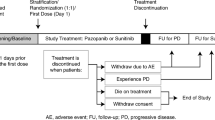Abstract
To investigate the sequential use of two tyrosine-kinase inhibitors (TKI), sorafenib (SOR) and sunitinib (SUN), in advanced renal carcinoma. We retrospectively analyzed the clinical outcome of 33 patients who had experienced progression or unacceptable toxicity after receiving either sorafenib or sunitinib and then switched to the other reciprocal agent. Progression-free survival (PFS) during the first TKI was similar regardless of drug with a median of 6 months in the SOR-SUN group (n = 15) and 7.5 months in the SUN-SOR group (n = 18). Interestingly, PFS during the second TKI was significantly longer in the SOR-SUN group as compared to the SUN-SOR group with median values of 11 and 3 months, respectively (P = 0.0377; HR 0.46; 95% CI: 0.16–0.95). As a consequence, total PFS (sum of PFS on first and second TKI) was significantly longer in the SOR-SUN group than in the SUN-SOR group with medians of 20 versus 10 months, respectively (P = 0.0393; HR 0.47; 95% CI: 0.18–0.96). Median wash-out period between the two TKI was 3 weeks in both groups. Differences in baseline characteristics, including histology and line of treatment, were not significant, and toxicity was not increased during the second part of the sequence. Here, we show that responses can be achieved when a second TKI is given soon after a TKI failure in renal cancer with apparent more durable disease control when SOR is followed by SUN.





Similar content being viewed by others
References
Motzer RJ, Russo P. Systemic therapy for renal cell carcinoma. J Urol. 2000;163:408–17.
Ainsworth NL, Lee JS, Eisen T. Impact of anti-angiogenic treatments on metastatic renal cell carcinoma. Expert Rev Anticancer Ther. 2009;9:1793–805.
Wilhelm SM, et al. BAY 43-9006 exhibits broad spectrum oral antitumor activity and targets the RAF/MEK/ERK pathway and receptor tyrosine kinases involved in tumor progression and angiogenesis. Cancer Res. 2004;64:7099–109.
Mendel DB, et al. In vivo antitumor activity of SU11248, a novel tyrosine kinase inhibitor targeting vascular endothelial growth factor and platelet-derived growth factor receptors: determination of a pharmacokinetic/pharmacodynamic relationship. Clin Cancer Res. 2003;9:327–37.
Di Lorenzo G. Phase II study of sorafenib in patients with sunitinib-refractory metastatic renal cell cancer. J Clin Oncol. 2009;27:4469–74.
Kontovinis L, et al. Sequential treatment with sorafenib and sunitinib in metastatic renal cell carcinoma: clinical outcomes from a retrospective clinical study. Med Oncol. 2011. doi:10.1007/s12032-010-9815-6.
Dudek AZ, Zolnierek J, Dham A, Lindgren BR, Szczylik C. Sequential therapy with sorafenib and sunitinib in renal cell carcinoma. Cancer. 2009;115:61–7.
Porta C, et al. Retrospective analysis of the sequential use of sorafenib and sunitinib in patients with advanced renal cell carcinoma. European association of urology congress. 2009. Abstract 252.
Sablin MP, et al. Sequential sorafenib and sunitinib for renal cell carcinoma. J Urol. 2009;182:29–34.
Choueiri T, et al. Treatment and dosing patterns for angiogenesis inhibitor (AIS) therapies in patients with metastatic renal cell carcinoma (MRCC). Ann Oncol. 2008; Suppl 8: Abstract p 593.
Huang D, et al. Interleukin-8 mediates resistance to antiangiogenic agent sunitinib in renal cell carcinoma. Cancer Res. 2010;70:1063–71.
Hammers HJ, et al. Reversible epithelial to mesenchymal transition and acquired resistance to sunitinib in patients with renal cell carcinoma: evidence from a xenograft study. Mol Cancer Ther. 2010;9:1525–35.
Tang TC, et al. Development of a resistance-like phenotype to sorafenib by human hepatocellular carcinoma cells is reversible and can be delayed by metronomic UFT chemotherapy. Neoplasia. 2010;12:928–40.
Author information
Authors and Affiliations
Corresponding author
Rights and permissions
About this article
Cite this article
Calvani, N., Morelli, F., Leo, S. et al. Sequential use of sorafenib and sunitinib in advanced renal cell carcinoma: does the order of sequencing matter?. Med Oncol 29, 1908–1913 (2012). https://doi.org/10.1007/s12032-011-0048-0
Received:
Accepted:
Published:
Issue Date:
DOI: https://doi.org/10.1007/s12032-011-0048-0




